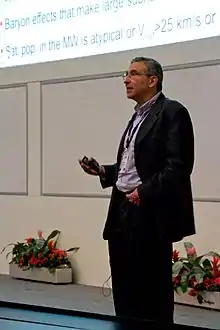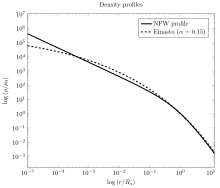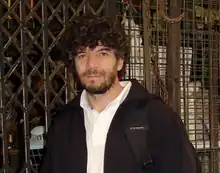Carlos Frenk
Carlos Silvestre Frenk CBE FRS (born 27 October 1951) is a Mexican-British cosmologist.[1] Frenk graduated from the National Autonomous University of Mexico and the University of Cambridge, and spent his early research career in the United States, before settling permanently in the United Kingdom. He joined the Durham University Department of Physics in 1986 and since 2001 has served as the Ogden Professor of Fundamental Physics at Durham University.[2]
Carlos Frenk | |
|---|---|
 Carlos Frenk in 2012 | |
| Born | Carlos Silvestre Frenk 27 October 1951 |
| Citizenship | British, German and Mexican |
| Alma mater | University of Mexico (BSc) University of Cambridge (PhD) |
| Known for | Navarro–Frenk–White profile |
| Spouse | Dr Susan Frenk |
| Children | 2 |
| Awards |
|
| Scientific career | |
| Fields | Astrophysics |
| Institutions | Durham University University of Sussex University of California, Santa Barbara University of California, Berkeley |
| Thesis | Globular clusters in the galaxy and in the Large Magellanic Cloud (1981) |
| Doctoral advisor | Bernard J. T. Jones |
| Doctoral students | Ben Moore Gillian Wilson |
| Website | star-www |
Frenk is particularly notable for his work around galaxy formation, including his use of complex computer simulations to test theories on the origins and evolution of the universe, thus helping to resolve disputes among theoretical models. Among the most prolific and frequently cited authors in astronomy and space science, Frenk has written more than 500 scientific articles; he is a co-author on 5 of the 100 most cited papers ever published within his field.[2]
As a pioneer in computational astrophysics, Frenk, alongside Marc Davis, George Efstathiou, and Simon White, published a series of influential papers that established the validity of the cold dark matter hypothesis through computer modelling.
Elected a Fellow of the Royal Society in 2004, Frenk has received numerous awards and is regularly tipped as a contender for the Nobel Prize in Physics.
Early life and education
Carlos Frenk was born in Mexico City, Mexico and is the eldest son of six siblings.[3] His father is a German Jewish doctor who emigrated from Germany at the age of 7, fleeing persecution in the lead up to World War II. His mother is a Mexican–Spanish pianist.[4] As a youth, Frenk showed some talent for basketball and played semi-professionally, but realised he would not be tall enough to turn pro.[5] The other half of his life was devoted to mathematics.[5]
Frenk studied engineering at the National Autonomous University of Mexico but later changed to Theoretical Physics, earning his undergraduate degree in 1976.[1][4] He gained the highest marks in his year, and so was awarded the Gabino Barreda Medal.[5] He visited Italy, where he attended a guest lecture by Martin Rees, then a Professor at the University of Cambridge. Encouraged by Rees, Frenk abandoned his plan to study at Caltech and tried for Cambridge instead.[5]
That year he secured a British Council Fellowship and enrolled at the University of Cambridge to read Part III of the Mathematical Tripos, which he completed in 1977. He remained at Cambridge for doctoral studies under the supervision of Bernard J. T. Jones.[6] His doctoral research explored the properties of the Milky Way.[5] The idea of dark matter was still "extremely speculative" at this point, but Frenk concluded that the galaxy was surrounded with "embedded" dark matter.[5][lower-alpha 1] He was awarded his PhD in astronomy in 1981.[8]
At Cambridge, Frenk decided to shift his research focus to cosmology because he felt there was still plenty of "exciting problems" within this field left to be solved; he thought particle physics was "moving rather slowly" and, despite help from professors, could not identify a suitable fundamental physics project for doctoral research that engaged his interest.[9] He met future collaborator Simon White for the first time at Cambridge. White, already a post-doc, acted as what Frenk later called his "unofficial supervisor".[5]
Career and research
Early career
Following Cambridge, Frenk worked as a postdoctoral researcher at the University of California. He was based in Berkeley from 1981 to 1983, having been invited here by Marc Davis, an astronomer who had recently left Harvard.[5] He was then based in Santa Barbara from 1983 to 1984. He subsequently returned to the United Kingdom, where he was a postdoc at Sussex University from 1984 to 1985.[3]
The Gang of Four
At Berkeley, Davis needed Frenk, with his background in theoretical physics, to assist in interpreting his research — he had mapped 2,200 galaxies while at Harvard. Meanwhile, White had also moved to Berkeley.[5] This allowed the trio of Davis, White and Frenk to work together on what would prove to be a significant advance in astrophysics.[5]
The trio intended to use computer modelling to investigate the early state of the universe.[5] At this time, computational astronomy was a very new discipline.[5] In need of assistance, they recruited George Efstathiou, a recent PhD from Durham University, to help them.[5] Having become a foursome, the group worked on a series of papers — they were particularly interested in the supersymmetric theory that dark matter particles were "cold".[5] One of their first conclusions was that dark matter could not be made of neutrinos.[5] In 1985, they published their most significant paper in The Astrophysical Journal, entitled The evolution of large-scale structure in a universe dominated by cold dark matter, which revealed the results of the first simulations of cold dark matter.[10]
Once their research started to draw important results – despite the limited computing power available to them – Davis, White, Efstathiou, and Frenk came to be known as the 'Gang of Four' for the attention their arguments attracted.[5] The research produced by the Gang of Four confirmed the validity of the "cold dark matter theory" for the formation of galaxies and other cosmic structures.[3] While their arguments were not without their detractors, this would eventually become the accepted interpretation in cosmology.[3]
Move to Durham
In 1986, Frenk was appointed Lecturer at Durham University, having been recruited by Richard Ellis.[3][5] He found the physics department in Durham to be "tiny" upon his arrival, with "no theory" and astronomy "non-existent".[5] With Ellis' support he worked on strengthening the profile of the department in astronomical research; this was not easy, as Frenk struggled to access the computing power demanded by his computational approach.[5] He eventually secured a model from the MicroVAX series at a cost of £40,000, after trying and failing to borrow computers from commercial laboratories.[5] Frenk was promoted to Reader in 1991 and then made full Professor in 1993.[5] During this period of his career he turned down job offers from both the United States and Mexico.[11]
In spite of the impact created by their papers, Frenk and White's theories did not represent the scientific consensus at this time. They had been "under siege" during the late 80s and early 90s by academics who suggested alternative explanations to the concept of dark matter.[5] The most notable alternative theory was the Modified Newtonian dynamics proposed by Israeli physicist Mordehai Milgrom in 1981.[7] However, in 1993 evidence from the Cosmic Background Explorer offered further support for Frenk and White.[5][lower-alpha 2]
Research efforts at Durham were boosted by the 1994 announcement of the High Performance Computing Initiative, which promised more resources from the government in future.[5] By now, White was based at the Max Planck Institute, and he and Frenk joined their institutions with other computational astronomers to form the Virgo Consortium.[5][lower-alpha 3] Crucially, this gave Frenk and his team access to the supercomputing centre of the Max Planck Society in Garching, regarded as among the best facilities in the world.[5]
Navarro-Frenk-White profile
The "paradigm of cold dark matter" had become firmly established by the mid-1990s; predictions of cosmological simulations therefore shifted away from the distribution of cold dark matter halos to the shapes of those halos.[10]
In 1996, Frenk, White, and lead author Julio Navarro of the University of Arizona, published a remarkable result based on their analysis of halos from cold dark matter simulations.[10] This was the Navarro-Frenk-White profile, a model profile for dark matter halos. Essentially, it is a spatial mass distribution of dark matter fitted to dark matter halos. The formula is still widely used today.[10]
 Comparison of NFW and Einasto profile
Comparison of NFW and Einasto profile
2001–present
.jpg.webp)
Following an endowment from Computacenter founder Peter Ogden in 2001, Frenk was named the inaugural Ogden Professor of Fundamental Physics at Durham University and continues to hold this position today.[5][lower-alpha 4] Frenk became the Director of the Institute for Computational Cosmology (ICC) upon its establishment in 2001. He held this post until 2020, at which point he was succeeded by Durham colleague Shaun Cole.[13][14]
In 2005, as a member of the Virgo Consortium, Frenk was part of a team that produced the 'Millenium Simulation', which was then the largest and most realistic N-body simulation.[15][5] It took 28 days to run.[5] In a later interview, Frenk summarised his cosmological simulation work as "cosmic cookery" because it depended on selecting just the right "ingredients", putting it into a computer, and letting it "cook".[16] He joked that he and his colleagues at the ICC had "filing cabinets" full of failed universes.[16]
By 2008 Frenk was one of the top 10 most cited astronomers in the world.[5] In 2020, Frenk was named a Clarivate Citation Laureate for his highly-cited research, which was judged to be of "Nobel Class".[17] Frenk, along with Julio Navarro and Simon White, was tipped as a potential winner of the 2020 Nobel Prize in Physics; though victory at a later date was considered a greater possibility given the award the previous year (to a team led by Princeton astrophysicist Jim Peebles) had been for work that was also within the realm of space science.[18] In 2021 the trio of Frenk, Navarro and White was again named as a strong contender for that years Nobel.[19][lower-alpha 5]
Personal life
Frenk is married to Susan Frenk, a lecturer in Spanish and Latin American literature and current Principal of St Aidan's College. They have two sons.[11]
Frenk has an interest in architecture, which was inspired by his experience studying at the main campus of the National Autonomous University of Mexico, a UNESCO World Heritage site.[21] He was unimpressed with the state of academic buildings when he first moved to Britain, describing them as "dark, claustrophobic and in a state of disrepair" and has taken an active role in the design process of new buildings at Durham University.[21]
Media
Frenk was interviewed by Kirsty Young for Desert Island Discs, first broadcast in 2018.[4]
Awards and recognition
Frenk was elected a Fellow of the Royal Society (FRS) in 2004.[22] He was appointed Commander of the Order of the British Empire (CBE) in the 2017 Birthday Honours for services to cosmology and the public dissemination of basic science.[23]
He received the Gold Medal of the Royal Astronomical Society in 2014.[24]
Other awards include the Royal Society Wolfson Research Merit Award (2006), the Daniel Chalonge Medal of the Paris Observatory (2007), the George Darwin Lectureship (2010), the Fred Hoyle Medal and Prize of the Institute of Physics (2010), the Gruber Prize in Cosmology (2011), the Max Born Prize of the German Physical Society (2017), the Dirac Medal and Prize of the Institute of Physics (2020), and the Rumford Medal (2021).[25][26][3][27][28][29]
References
Notes
- In layman terms, dark matter is a hypothetical material said to make up 85% of space matter. Dark matter theory emerged as an explanation for why, contrary to Newtonian physics, almost all stars in a spiral galaxy race around the centre at the same speed, rather than moving more slowly the closer to the edge. This observation was first made by Vera Rubin.[7]
- By 2006, despite the popularity of Milgrom's idea in some quarters, dark matter had the backing of the "vast majority" of scientists.[7]
- As of 2018, Frenk continued to serve on the steering committee of the Virgo Consortium.[12]
- Ogden had previously studied Physics at Durham before entering the business world.[5]
- The 2021 Nobel Prize in Physics was eventually awarded to Syukuro Manabe, Klaus Hasselmann, and Giorgio Parisi.[20]
Citations
- Anon (2017). "Frenk, Prof. Carlos Silvestre". Who's Who (online Oxford University Press ed.). Oxford: A & C Black. doi:10.1093/ww/9780199540884.013.U16471. (Subscription or UK public library membership required.)
- "Carlos Frenk CV" (PDF). (90.3 KB)
- "Carlos Frenk". Gruber Foundation. 2011. Retrieved 24 April 2023.
- "Professor Carlos Frenk". Desert Island Discs. BBC Radio 4. Retrieved 28 September 2021.
- "The universe in a desktop". Scientific Computing World. Europa Science Ltd. 8 May 2008. Retrieved 27 April 2023.
- Carlos Frenk at the Mathematics Genealogy Project
- "Most of Our Universe is Missing". BBC Online. 10 February 2006. Archived from the original on 24 September 2022. Retrieved 29 April 2023.
- Frenk, Carlos Silvestre (1981). Globular clusters in the galaxy and in the Large Magellanic Cloud. Cambridge University (PhD thesis). University of Cambridge. OCLC 556480531. EThOS uk.bl.ethos.255877.
- Kibble, Bob (1997). Physics in Space. London: Heinemann. p. 78. ISBN 9780435688431.
- Gianfranco Bertone; Dan Hooper (24 May 2016). "A History of Dark Matter" (PDF). Fermilab. p. 61. Retrieved 28 April 2023.
- "A marriage of minds". Times Higher Education (THE). 4 November 1994. Retrieved 24 April 2023.
- "About the Virgo Consortium". Virgo Consortium. Retrieved 26 December 2018.
- "Professor Frenk's cv". star-www.dur.ac.uk. Retrieved 20 November 2020.
- "Institute for Computational Cosmology". Durham University. Retrieved 20 November 2020.
- "Millennium Simulation – the largest ever model of the Universe". Durham University. 2 June 2005. Retrieved 27 April 2023.
- Adam Hart-Davis (2007). The Cosmos : A Beginner's Guide. London: BBC Books. pp. 26–27. ISBN 9781846072123.
- Waters, Richard (29 September 2020). "Durham Cosmologist recognised as being "of Nobel class" for work on evolution of the universe". Palatinate. Retrieved 24 April 2023.
- Hunt, Katie (2 October 2020). "Why it's so hard to guess who's going to get a Nobel Prize". CNN. Retrieved 24 April 2023.
- "Invisibility cloak and quantum physics tipped for Nobel Prize". France 24. 5 October 2021. Retrieved 24 April 2023.
- "The Nobel Prize in Physics 2021". Nobel Foundation. 5 October 2021. Archived from the original on 5 October 2021. Retrieved 6 October 2022.
- Lock, Helen (30 November 2015). "The cosmologist who makes beautiful university buildings appear". The Guardian. Retrieved 24 April 2023.
- "Carlos Frenk". Royal Society. Retrieved 27 April 2023.
- "No. 61962". The London Gazette (Supplement). 17 June 2017. p. B8.
- "RAS Awards 2014". Astronomy & Geophysics. 55: 1.37–1.38. February 2014. doi:10.1093/astrogeo/atu040.
- "The George Darwin Lectures" (pdf). Royal Astronomical Society. 2022. Retrieved 21 March 2023.
- "Fred Hoyle Medal and Prize recipients". Institute of Physics. Retrieved 21 March 2023.
- "Born medal recipients". Institute of Physics. Retrieved 21 March 2023.
- "2020 Paul Dirac Medal and Prize". Institute of Physics. Retrieved 21 March 2023.
- "Prestigious Award for Galaxy Evolution Research". Durham University. 24 August 2021. Retrieved 21 March 2023.
External links
 Media related to Carlos Frenk at Wikimedia Commons
Media related to Carlos Frenk at Wikimedia Commons